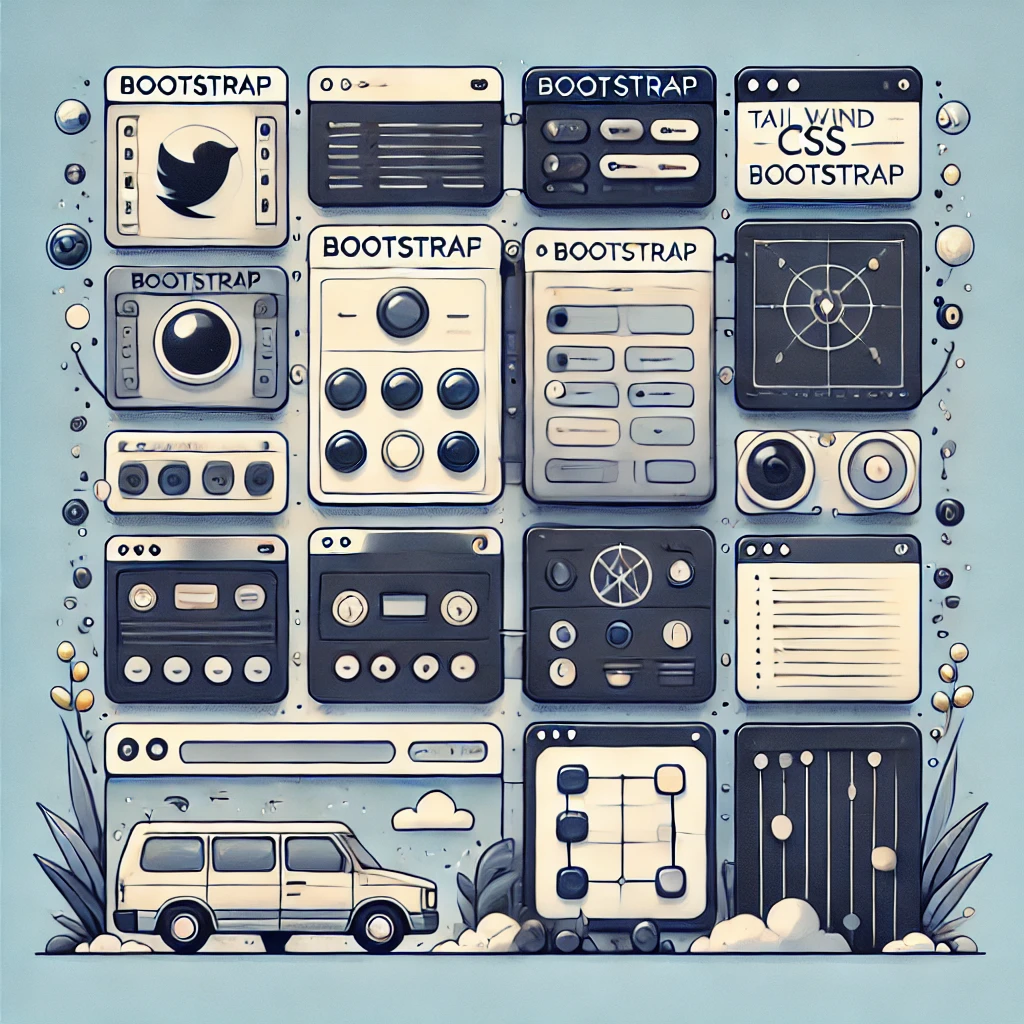Choosing between Tailwind CSS and Bootstrap depends on your project’s needs, your team’s workflow, and your preference for design flexibility vs. ease of use. Here’s a breakdown of both to help you decide:
1. Ease of Use
- Bootstrap:
- Pre-built Components: Bootstrap comes with a wide variety of pre-designed components (like buttons, navbars, forms, modals, etc.) that are ready to use out-of-the-box.
- Grid System: It offers a 12-column grid system, which is helpful for responsive layouts.
- Quick Setup: You can get a fully functional layout quickly, even if you don’t know much about CSS.
- Best For: Developers who want to get up and running fast, without spending too much time on custom designs.
- Tailwind CSS:
- Utility-first Approach: Tailwind takes a utility-first approach, which means you style elements by applying predefined classes directly to your HTML (like
bg-blue-500,text-xl,p-4). - No Pre-built Components: It doesn’t come with pre-designed components, so you’re responsible for creating your own UI design, which offers more customization.
- Learning Curve: It may have a steeper learning curve at first, especially if you’re not familiar with utility-first CSS.
- Utility-first Approach: Tailwind takes a utility-first approach, which means you style elements by applying predefined classes directly to your HTML (like
- Verdict: If you want to build quickly with minimal effort, Bootstrap is easier to start with. However, Tailwind is better for flexibility and creating fully customized designs.
2. Customization & Flexibility
- Bootstrap:
- Customization can be more difficult because you are limited to what Bootstrap provides (although it can be customized through variables).
- It tends to have a specific design aesthetic, which might not match your brand without extra work.
- Tailwind CSS:
- Highly Customizable: Tailwind allows you to fully customize your design. You can modify colors, spacing, breakpoints, etc., directly through configuration files.
- Tailwind doesn’t enforce any design patterns, so you can design exactly how you want without being restricted by pre-made styles.
- Verdict: If you need a unique design and total control over the styling, Tailwind CSS is the clear winner. Bootstrap may require more work to make your project stand out visually.
3. Performance
- Bootstrap:
- Generally, it comes with a larger file size because it includes lots of unused CSS and JavaScript components that might not even be used in your project.
- Tailwind CSS:
- Optimized for Performance: Tailwind’s utility-first approach means that only the classes you use are included in the final build. Tools like PurgeCSS remove unused styles, making Tailwind projects potentially smaller in size.
- Verdict: For better performance, Tailwind CSS is often more efficient because you can reduce the unused CSS.
4. Community & Ecosystem
- Bootstrap:
- Large Community: Bootstrap has been around for a long time and has a huge ecosystem of plugins, themes, and resources.
- Extensive Documentation: It’s known for having clear documentation and lots of tutorials.
- Tailwind CSS:
- Growing Community: Tailwind is newer, but its community is growing quickly, and it’s gaining a lot of traction in the development world.
- Plugin Ecosystem: Tailwind has a growing number of plugins for different use cases, and resources are also improving.
- Verdict: Bootstrap has the larger established community, but Tailwind CSS is quickly catching up and has an enthusiastic user base.
5. Development Workflow
- Bootstrap:
- Can make development faster in terms of getting basic layouts and components running quickly.
- You can use its grid system and pre-made components without having to write much custom CSS.
- Tailwind CSS:
- Custom Development Workflow: It might slow things down initially because you’re writing your own components using utility classes, but it can lead to cleaner, more maintainable code in the long run.
- Requires more focus on planning how your UI should look and behaves, giving you more control.
- Verdict: If you prefer to use ready-made components and fast development cycles, Bootstrap will fit well. If you want more control over your design and development, Tailwind will give you a lot of freedom.
6. Design Philosophy
- Bootstrap: Follows a specific design style, which can lead to a more uniform look across projects. This can be good for consistency but limiting in terms of design freedom.
- Tailwind CSS: Emphasizes a more atomic, “build-your-own” approach to design. This means you can create unique layouts, but it also requires more design effort.
Conclusion:
- Use Bootstrap if you:
- Need a quick, ready-to-go framework with pre-designed components.
- Prefer a more traditional approach to layout with minimal setup.
- Don’t want to worry too much about custom design.
- Use Tailwind CSS if you:
- Want full control over the design and layout.
- Prefer working with utility classes for a highly customized UI.
- Are comfortable with a bit more upfront work for a unique, optimized project.
Ultimately, both tools are excellent for different needs, and your choice should depend on how much flexibility, customization, and speed you need for your project.
Example:
Here are some simple examples to illustrate the differences between Bootstrap and Tailwind CSS for building a basic card component.
1. Bootstrap Example (Card Component)
In Bootstrap, you can create a card with pre-designed components, just by adding the appropriate classes:
<!DOCTYPE html>
<html lang="en">
<head>
<meta charset="UTF-8">
<meta name="viewport" content="width=device-width, initial-scale=1.0">
<title>Bootstrap Card</title>
<link href="https://stackpath.bootstrapcdn.com/bootstrap/4.5.2/css/bootstrap.min.css" rel="stylesheet">
</head>
<body>
<div class="card" style="width: 18rem;">
<img src="https://via.placeholder.com/150" class="card-img-top" alt="Card image">
<div class="card-body">
<h5 class="card-title">Card Title</h5>
<p class="card-text">Some quick example text to build on the card title and make up the bulk of the card's content.</p>
<a href="#" class="btn btn-primary">Go somewhere</a>
</div>
</div>
</body>
</html>
What Happens in This Code?
- The card is styled using Bootstrap’s pre-made classes (
card,card-body,card-title,card-img-top, andbtn btn-primary). - You just need to structure the HTML and add the relevant Bootstrap classes.
2. Tailwind CSS Example (Card Component)
In Tailwind CSS, you build your own custom styling using utility classes. Here’s the same card built with Tailwind:
<!DOCTYPE html>
<html lang="en">
<head>
<meta charset="UTF-8">
<meta name="viewport" content="width=device-width, initial-scale=1.0">
<title>Tailwind Card</title>
<script src="https://cdn.tailwindcss.com"></script>
</head>
<body class="flex justify-center items-center h-screen bg-gray-100">
<div class="max-w-sm rounded overflow-hidden shadow-lg bg-white">
<img src="https://via.placeholder.com/150" alt="Card image" class="w-full">
<div class="px-6 py-4">
<h5 class="font-bold text-xl mb-2">Card Title</h5>
<p class="text-gray-700 text-base">Some quick example text to build on the card title and make up the bulk of the card's content.</p>
</div>
<div class="px-6 pt-4 pb-2">
<a href="#" class="bg-blue-500 text-white px-4 py-2 rounded hover:bg-blue-700">Go somewhere</a>
</div>
</div>
</body>
</html>
What Happens in This Code?
- The card is built from scratch using utility classes (
max-w-sm,rounded,shadow-lg,bg-white,px-6,py-4, etc.). - Tailwind gives you a lot of control over the design, like setting padding (
px-6,py-4), background color (bg-white,bg-blue-500), hover effects, and text colors (text-gray-700).
Key Differences in the Examples:
- Bootstrap:
- You use predefined classes for layout and components, which results in faster development for standard components.
- The styling is mostly done for you, so you can focus on just organizing your HTML structure.
- Tailwind CSS:
- You define the design using utility classes, which allows more customization and flexibility for unique design needs.
- It requires more class names and could take a bit longer to write, but you have full control over the design from the ground up.
Customization:
- Bootstrap allows you to customize the styles via variables (SASS) or overriding classes, but it’s still limited to its existing components.
- Tailwind provides an out-of-the-box configuration file where you can change things like color palettes, spacing, and breakpoints easily.
Conclusion:
- Bootstrap is great when you need a quick, standardized layout.
- Tailwind CSS shines when you want more control and a custom design without having to write CSS from scratch.
Let me know if you’d like more examples or have further questions!
At 7Shades Digital, we specialised in creating strategies that help businesses excel in the digital world. If you’re ready to take your website to the next level, contact us today!





